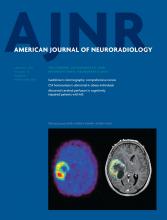Research ArticleBrain
Open Access
Perfusion-Weighted Imaging–Derived Collateral Flow Index is a Predictor of MCA M1 Recanalization after IV Thrombolysis
F. Nicoli, P. Lafaye de Micheaux and N. Girard
American Journal of Neuroradiology January 2013, 34 (1) 107-114; DOI: https://doi.org/10.3174/ajnr.A3174
F. Nicoli
aFrom the Service d'Urgences Neuro-Vasculaires (F.N.)
P. Lafaye de Micheaux
cDépartement de Mathématiques et Statistique (P.L.d.M.), Université de Montreal, Montreal, Canada.
N. Girard
bService de Neuroradiologie (N.G.), Assistance Publique-Hôpitaux de Marseille (APHM), CHU de la Timone, Marseille, France

References
- 1.↵
- Liebeskind DS
- 2.↵
- 3.↵
- Lima FO,
- Furie KL,
- Silva GS,
- et al
- 4.↵
- Nogueira RG,
- Liebeskind DS,
- Sung G,
- et al
- 5.↵
- Tan IYL,
- Demchuk AM,
- Hopyan J,
- et al
- 6.↵
- Bang OY,
- Saver JL,
- Buck BH,
- et al
- 7.↵
- McVerry F,
- Liebeskind DS,
- Muir KW
- 8.↵
Tissue plasminogen activator for acute ischemic stroke. The National Institute of Neurological Disorders and Stroke rt-PA Stroke Study Group. N Engl J Med 1995;333:1581–87
- 9.↵
- 10.↵
- Nicoli F,
- Squarcioni C,
- Grimaud L,
- et al
- 11.↵
- 12.↵
- Wu O,
- Østergaard L,
- Weisskoff RM,
- et al
- 13.↵
- Takasawa M,
- Jones PS,
- Guadagno JV,
- et al
- 14.↵
- Olivot JM,
- Mlynash M,
- Thijs VN,
- et al
- 15.↵
R Development Core Team. R: A language and environment for statistical computing, R Foundation for Statistical Computing version 2.11.0 (2010–04-22). Vienna, Austria: http://www.R-project.org
- 16.↵
- Long JS
- 17.↵
- Khatri P,
- Neff J,
- Broderick JP,
- et al
- 18.↵
- Han A,
- Yoon DY,
- Chang SK,
- et al
- 19.↵
- Zangerle A,
- Kiechl S,
- Spiegel M,
- et al
- 20.↵
- Molina CA,
- Alexandrov AV,
- Demchuk AM,
- et al
- 21.↵
- Alexandrov AV,
- Grotta JC
- 22.↵
- Fieselmann A,
- Kowarschik M,
- Ganguly A,
- et al
- 23.↵
- 24.↵
- Shuaib A,
- Butcher K,
- Mohammad AA,
- et al
- 25.↵
- Wunderlich MT,
- Goertler M,
- Postert T,
- et al
- 26.↵
- Kirchhof K,
- Sikinger M,
- Welzel T,
- et al
- 27.↵
- Röther J,
- Schellinger PD,
- Gass A,
- et al
- 28.↵
- Jovin TG,
- Gupta R,
- Horowitz MB,
- et al
- 29.↵
- 30.↵
- Saqqur M,
- Tsigovlis G,
- Nicoli F,
- et al
In this issue
Advertisement
F. Nicoli, P. Lafaye de Micheaux, N. Girard
Perfusion-Weighted Imaging–Derived Collateral Flow Index is a Predictor of MCA M1 Recanalization after IV Thrombolysis
American Journal of Neuroradiology Jan 2013, 34 (1) 107-114; DOI: 10.3174/ajnr.A3174
0 Responses
Jump to section
Related Articles
- No related articles found.
Cited By...
- Collateral status and recanalization after endovascular treatment for acute ischemic stroke
- Collateral status and recanalization after endovascular treatment for acute ischemic stroke
- Clinical prognosis of FLAIR hyperintense arteries in ischaemic stroke patients: a systematic review and meta-analysis
- Incidence and Predictors of Early Recanalization After Intravenous Thrombolysis: A Systematic Review and Meta-Analysis
- Acute ischaemia after subarachnoid haemorrhage, relationship with early brain injury and impact on outcome: a prospective quantitative MRI study
- Time and Diffusion Lesion Size in Major Anterior Circulation Ischemic Strokes
- Hypoperfusion Intensity Ratio Predicts Infarct Progression and Functional Outcome in the DEFUSE 2 Cohort
This article has not yet been cited by articles in journals that are participating in Crossref Cited-by Linking.
More in this TOC Section
Similar Articles
Advertisement











